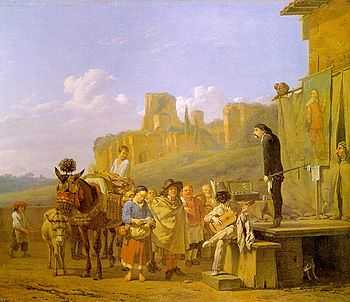Bamboccianti

The Bamboccianti were genre painters active in Rome from about 1625 until the end of the seventeenth century. Most were Dutch and Flemish artists who brought existing traditions of depicting peasant subjects from sixteenth-century Netherlandish art with them to Italy,[1] and generally created small cabinet paintings or etchings of the everyday life of the lower classes in Rome and its countryside.[2] Many of the artists were also members of the Bentvueghels. Their paintings have been traditionally interpreted as a realist "true portrait of Rome and its popular life"[3] "without variation or alteration" of what the artist sees.[4] Typical subjects include food and beverage sellers, farmers and milkmaids at work, soldiers at rest and play, and beggars,[2] or, as Salvator Rosa lamented in the mid-seventeenth century, "rogues, cheats, pickpockets, bands of drunks and gluttons, scubby tobacconists, barbers, and other 'sordid' subjects."[3] In contrast to their painted topics, the works themselves sold for high prices to esteemed collectors.[5]
As Karel Dujardin's genre subject of peasants and mountebanks demonstrates, such realistic groupings might be set in idealized settings of noble ruins of the Roman Campagna.
Artists
The term originates from the Bentvueghel nickname of the Dutch painter Pieter van Laer, "Il Bamboccio", around whom these artists gathered during his stay in Italy (1625–1639).[3] The artist's alias, which means "ugly doll" or "puppet", alludes to van Laer's physical proportions,[3] as well as the puppet size of his figures.[citation needed] The initial bamboccianti included Andries and Jan Both, Karel Dujardin, Jan Miel, Johannes Lingelbach and the Italian Michelangelo Cerquozzi. Sébastien Bourdon is also associated with this group during his early career.[6] Other Bamboccianti include Michiel Sweerts, Thomas Wijck, Dirck Helmbreker, Jan Asselyn, Anton Goubau, Willem Reuter, and Jacob van Staveren.[7] They were to influence Rococo artists such as Antonio Cifrondi, Pietro Longhi, Giuseppe Maria Crespi, Giacomo Ceruti, and Alessandro Magnasco,[citation needed] and their paintings of everyday Roman life continued into the nineteenth century through the works of Bartolomeo and Achille Pinelli, Andrea Locatelli and Paolo Monaldi.[8] A Bambocciante not yet identified painted also Assalto d'armati, a fighting image, now in the Forlì "Pinacoteca Civica" (City Art Gallery).
Characteristics
Giambattista Passeri, a seventeenth-century chronicler of art, described van Laer's work as an "open window" that provides an accurate representation of the world around him, characteristics applied to the bamboccianti in general:[9][10]
"era singular nel represetar la veritá schietta, e pura nell'esser suo, che li suoi quadri parevano una finestra aperta pe le quale fussero veduti quelli suoi successi; senza alcun divario, et alterazione."
"[he] was unique in representing the truth, in its pure essence, such that his paintings appear to us like an open window through which we can see all that happens, without divergence or alteration"
Critical reception
Although the bamboccianti found success with their pictures, artistic theoreticians and academics in Rome were often unkind—paintings of everyday life generally being regarded lowly within the hierarchy of genres.[2] The fact that otherwise well-learned and aristocratic patrons continued to purchase works by these artists was frequently bemoaned by painters of histories and other genres within the accepted canon of the city's main artistic establishment, Academy of St. Luke.[2][11] For example, Salvator Rosa, in his satire on painting Pittura (c. 1650), complains bitterly about the taste of the aristocratic patrons and their acceptance of such everyday subjects:[11][12]
"Quel che aboriscon vivo, aman dipinto."
"Those they abhor in life, are loved in paint"
More often than not, as is reflected in Rosa's comment, such derision was directed not at the artists, but towards those who actually bought the works.[13] The artists themselves were often admired, with van Laer being known as an artist whose works were pricey and Michelangelo Cerquozzi gaining access to aristocratic circles and befriending artists such as Pietro da Cortona.[14] Additionally, since many of the bamboccianti were foreigners painting outside of the Academy's interests they often joined the Schildersbent, a loosely organized guild—known primarily for its lavish and drunken festivities—that providing representation and acted as an alternative to the official establishment.[15] Acceptance of the bamboccianti in the Academy was not forbidden, however, as Van Laer and Cerquozzi are associated with both (van Laer was also a member of the Schildersbent).[16]
Notes
- ↑ Levine, p. 570.
- ↑ 2.0 2.1 2.2 2.3 Haskell, pp. 132–134.
- ↑ 3.0 3.1 3.2 3.3 Levine, pp. 569–570. The quotation is from Levine (p. 570).
- ↑ Briganti, p. 2.
- ↑ Haskell, p. 135.
- ↑ Brigstocke
- ↑ Slive, pp. 236–237; Briganti, ix.
- ↑ Briganti, 36.
- ↑ Briganti, pp. 6–12.
- ↑ Haskell, p. 132.
- ↑ 11.0 11.1 Roworth, 611–617.
- ↑ Haskell, p. 134
- ↑ Haskell, p. 142.
- ↑ Haskell, pp. 135–136.
- ↑ Haskell, p. 20.
- ↑ Haskell, pp. 20–21.
Sources
- Briganti, Giuliano (1983). The bamboccianti the painters of everyday life in seventeenth century Rome. U. Bozzi.
- Brigstocke, Hugh. "Bourdon, Sébastien", Grove Art Online. Oxford University Press, [October 30, 2007].
- Haskell, Francis (1993). "Chapter 8". Patrons and Painters: Art and Society in Baroque Italy. Yale University Press. ISBN 0-300-02537-8.
- Levine, David A. (December 1988). "The Roman Limekilns of the Bamboccianti". The Art Bulletin (College Art Association) 70 (4): 569–589. doi:10.2307/3051103. JSTOR 3051103
- Roworth, Wendy W. (December 1981). "A Date for Salvator Rosa's Satire on Painting and the Bamboccianti in Rome". The Art Bulletin (College Art Association) 63 (4): 611–617. doi:10.2307/3050166. JSTOR 3050166
- Slive, Seymour (1995). "Italianate and Classical Painting". Pelican History of Art, Dutch Painting 1600–1800. Penguin Books Ltd. pp. 225–245.
- Wittkower, Rudolf (1993). "Chapter 4". Pelican History of Art, Art and Architecture Italy, 1600–1750. 1980. Penguin Books Ltd. p. 323.
| Wikimedia Commons has media related to Bamboccianti. |